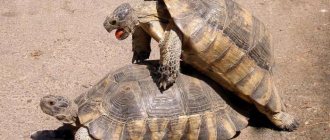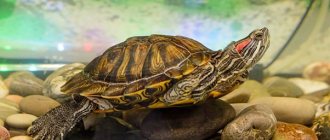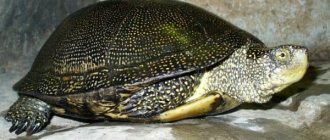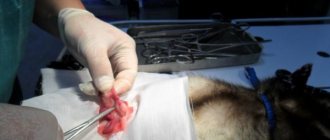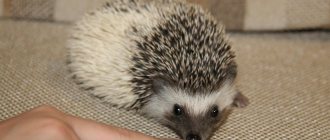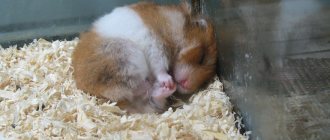The feasibility of artificial hibernation and preparation rules
The hibernation state has a positive effect on the reproductive system of reptiles, so experienced breeders send their pets into hibernation on their own.
IMPORTANT! If you have insufficient experience and there is no good reason, it is not recommended to hibernate a turtle, since caring for it at home is very problematic.
Preparing for hibernation includes the following steps:
- Increasing the size of the diet 2 months before falling asleep. During the winter, turtles do not eat and lose almost half of their weight. Without a layer of fat, a supply of nutrients and vitamins, the animal may die.
- Canceling feeding 1 week before wintering. Additionally, the water level decreases.
- Smooth decrease in temperature over 10 days. Turtles are lethargic at temperatures below 15°, and at temperatures below 10° they go into hibernation.
- Gradual reduction of daylight hours over 10 days. Reduce lamp operating hours, turn off filters and increase room humidity.
- Bathe your reptile on the last day before wintering. A warm water bath will help you relax and empty your bowels.
IMPORTANT! Check the sleeping turtle every 3 days and spray the soil with water to maintain moisture.
Remember that during hibernation it is prohibited:
- wake up and put your pet back to sleep;
- awaken the reptile before daylight hours increase;
- carry out bathing, which triggers the process of urination when the shell comes into contact with water;
- continue sleeping with a strong decrease in body weight (the animal loses more than 10% within 1 month);
- Allow long-term cooling below 0°.
In addition to the terrarium, you can use a special plastic container. Before using it you must:
- Fill 10-30 cm with substrate (peat, sand, moss, sphagnum), dry leaves or decorative pieces of bark. The selected container should be well ventilated, and the substrate should remain dry even at high humidity.
- Cool on the balcony, in the basement or in the refrigerator for several days.
- Place in a cool, but draft-free place at a temperature of 6° to 10°. There is no need to warm the hibernation site, as this can provoke early awakening and disorientation of the animal.
After waking up, the turtle is bathed in warm baths to restore its usual temperature and start internal processes.
IMPORTANT! If after wintering the reptile shows lethargy and looks exhausted, then consult a veterinarian to find out the cause of the symptoms.
Wintering in the refrigerator
Another alternative to a suitable cool room for successful wintering is the use of a refrigerator. In this case, the following factors must be taken into account. First, the refrigerator must be large enough for the drawer to remain freely in it for a long time. And secondly, it should not be used for storing food. However, you should keep in mind that the back wall of the refrigerator is usually colder than the front, so the box with the turtle should not be placed close to the walls. In addition, once a day, you need to open the refrigerator for a while, thus maintaining natural air circulation. The temperature should be kept constantly at +4 – +7C. IMPORTANT!
1. After waking up, the turtle must be bathed in water, the temperature of which should be approximately 24 - 26 C. In this case, the turtle must drink a lot. After this, you should move the animal into a terrarium or a special box and turn on the lighting.
2. Next, you need to offer the turtle a fairly large amount of fresh food. It is quite normal if the animal eats practically nothing in the first week.
Pleasant awakening
Coming out of hibernation is an important moment in the life of a turtle, and it needs help to cope with this task. How to bring a turtle out of hibernation? All autumn reserves are used up, the turtle wakes up weak, exhausted and vulnerable to infections. At this moment, she needs care and quality nutrition more than ever.
After the turtle comes out of hibernation, it is warmed with a lamp or fan heater, then a “bath day” is arranged - in a small container with warm water. The turtle should bathe for about 10 minutes, this will restore the water balance in its body.
After hibernation, water procedures must be repeated every day for a week. They can be stopped when the reptile urinates for the first time. At first, her urine will be thick and dark yellow, but gradually the toxins will come out and it will become light in color again.
Now you can “sit down at the table,” of course, if its appetite has awakened along with the turtle. At first, the reptile may refuse food, this is normal, gradually everything will recover.
What signs can be used to determine that a turtle has safely emerged from hibernation? A healthy reptile's tongue will be pink or orange, without a coating. If it is bright red, the animal may be infected with something. The eyes should be clear and clean, also without plaque or discharge.
Habitats
The marsh turtle is distributed in North-West Africa, in Southern and Central Europe, to Smolensk and Ulyanovsk in the north, in Asia - in the east to the Irgiz River and the lower reaches of the Syrdarya, and in the south - to Iran, Iraq and Asia Minor.
It can be found in forest, forest-steppe and steppe areas. The marsh turtle is quite unpretentious in its choice of habitats and settles in bodies of water with weak currents; also common in lakes and floodplain channels among floodplains.
Prefers reservoirs with sloping banks overgrown with reeds, reeds, cattails and other wetland plants.
Preparation
So, how do red-eared turtles hibernate at home? About 2 months before hibernation, switch your pet to an enhanced diet so that she can store as many nutrients as possible
This is important because during hibernation animals lose weight by almost 2 times. It is useful to give your turtle special nutritional supplements (they are sold at the pet supply store)
But a week before bedtime, the animal needs to stop feeding altogether.
In order for the red-eared turtle to hibernate, gradually reduce the air temperature of the pet to 10 degrees. You cannot sharply reduce the temperature, as this can cause the reptile to die from temperature shock. Just before hibernation, do not forget to bathe your pet; at the same time, it will cleanse the intestines.
The ideal temperature during sleep is from 1 to 6 degrees Celsius. This regime can be ensured by placing the animal, for example, in the basement. However, be careful. Hypothermia is fatal for red-eared turtles. It is also necessary to maintain optimal humidity conditions. It can be provided by moistened moss and leaves. This environment is well ventilated.
According to science
What benefits did the census bring?
- First, it showed that the number of waterfowl is constantly growing (with slight fluctuations from year to year): for example, the number of mallards when the census began was only about 13 thousand.
- The number of bird species remaining in the urban environment for the winter is increasing.
- The study also showed an increase in the amount of water surface suitable for bird habitat.
At the same time, urban wintering birds as a natural phenomenon remain a little-studied phenomenon that awaits its researchers.
By the way, scientists have found a direct relationship between the economic well-being of urban residents and the number of urban ducks in ponds. After the crisis of the 90s, the total number of individuals in the duck population in city ponds began to decline and reached the level of just over 7 thousand mallards in 1997. But then the population began to grow again. Currently it has reached its maximum value. But, according to zoologists, this is not the limit.
A red-eared slider from the USA attacked water bodies in Moscow and the Moscow region
Alexander Zhirnov
The red-eared turtle (Trachemys scripta elegans), a characteristic inhabitant of freshwater bodies of North America, thanks to human negligence and good adaptability to various natural conditions, is actively settling in rivers and ponds of the Moscow region. Experts have long been saying that this species of reptile is a real invasive threat to central Russia.
Red-eared turtles, as it turned out, do not find it difficult to exist in Russian cold conditions due to their unique ability for long-term anaerobic existence at very low temperatures. Animals can sleep for three months, burrowing into the silt at the bottom of frozen bodies of water. They are fertile, mobile, omnivorous and enter sexual maturity early.
Russian ponds and rivers have been attacked by overseas guests in recent years due to the fact that they were turned out of the door by their previous owners - people who bought small, cute turtles, but later did not want to take care of large, not very fragrant and voracious pets. In indoor conditions, an adult red-eared slider requires an aquarium with a volume of 100 liters and enhanced nutrition. These reptiles usually live up to 40 years. All this makes them not very desirable in city apartments.
Few gullible buyers at bird markets know that the International Union for Conservation of Nature has included the red-eared turtle in the top hundred invasively dangerous plants and animals. In the United States, the invasion of these “cuties” was encountered after the end of World War II, when the demand for pets increased sharply. By 1996, their exports from the United States reached eight million. Israeli environmentalists were the first to sound the alarm. Red-eared animals have already occupied the territory of Spain, Italy and France and continue to actively expand their range to the north and east of Europe, displacing local species. Rare aquatic plants, almost all amphibians, aquatic insect larvae, and endangered aquatic and semi-aquatic invertebrate animals that are important for the functioning of ecosystems are under threat. The situation becomes especially acute in urban environments, where local organisms exist literally on the brink of survival. But this is where the red-eared turtle invasion begins.
Another danger is the ability of the red-eared turtle to spread a dangerous disease - salmonellosis, which is why the number of farms breeding these animals has long been reduced in the United States. Many European countries already have a range of measures in place to prevent the further spread of Trachemys scripta elegans. The European Union has introduced a complete ban on trade in this species.
In Moscow, in the last decade, there have been more and more cases of detection of the red-eared turtle. At first, environmentalists believed that she could not survive in the Russian cold, but practice has shown that this is not so. They are regularly found in the Tsaritsyn and Kuzminsky ponds, Yauza, Chermyanka, Mars and Dzhamgarovsky ponds, as well as in the Altufevskaya River. This year, Muscovites noticed American invaders in the Vorontsovsky and Chernevsky ponds.
Rules for caring for a sleeping turtle
If you notice the first signs of the approaching winter in a red-eared slider, be sure to consult with a veterinarian, who will examine it and tell you what needs to be done if the reptile actually hibernates.
During the winter, adhere to the following recommendations:
- Lower the water level. The turtle burrows into the ground, where it can sleep for a long time without rising to the surface. Oxygen is obtained by special membranes in the cloaca and oral cavity.
- Turn off additional lighting. The pet will have to go to the bottom to maintain warmth, so turn off the filtration and monitor the water level. Excessive movement will destroy the thermal layer, and a low water level will lead to freezing to the very bottom.
- Avoid feeding. Thanks to slow digestion, the turtle digests the food eaten the day before over the course of several months.
- Monitor your pet's well-being. Domestic turtles fall asleep as early as November, when daylight hours begin to shorten, and sleep for about 4 months. It happens that the reptile does not wake up even in February. In this case, you have to wake up the pet yourself.
If the turtle looks active or it is February, then gradually increase the temperature and light to normal. The recovery period takes from 5 to 7 days.
You can feed your pet only after returning to normal activity, but not earlier than the 5th day.
IMPORTANT! After winter is over, take your pet to a veterinary clinic for an examination. The doctor will identify possible complications and prescribe timely treatment if necessary.
Both laughter and sin: what you definitely shouldn’t do with a turtle
Photo: still from the movie “Teenage Mutant Ninja Turtles”
Under natural conditions, representatives of some species can live more than 150 years. In this regard, turtles are ahead of all vertebrates. The famous Madagascan Tui Malila was included in the Guinness Book of Records for her longevity - at the time of her death she was more than 190 years old. In captivity, medium-sized turtles live up to 30–60 years, but large ones can live up to 150. Experts attribute their longevity to a slow metabolism, like all cold-blooded turtles.
However, acquaintance with humanity is not always favorable for turtles. In the 18th century, turtles served as live canned food for sailors. The author of the work “Animal Life”, German zoologist Alfred Brehm, spoke about the relationship of sailors with turtles as follows:
“Captured turtles are usually turned over on their backs. There is no ceremony with them: they are simply put aside somewhere on the deck, a sail is stretched over them to protect them from the sun and they do not care about anything else, relying on their survivability. They are not given any food or drink.”
Today, turtle meat is used to make soup and stew, and the shell is used for decorative items and other trinkets.
Psychologist: where do people become cruel to animals?
Cruelty towards animals speaks of internal aggression. In fact, it has always been there: before in villages, if neighbors were arguing, one of them could calmly go and shoot the dog - however, in essence this is aggression towards the neighbor, and not towards the dog itself. In such cases, people simply project their anger onto animals.
Almost all animals depend on us, many of them get used to us - in this sense, a person acts as a manipulator, and some people enjoy the feeling of power over a weaker creature.
Personally, I am convinced that a person can be dangerous if he kills an animal not for the sake of eating it. Any living creature has a serious barrier to killing just like that. If a person shows unreasonable aggression towards animals, who knows what he might be capable of towards people.
Natalya Panfilova psychologist
Neighborhood with people is sometimes fraught with unintentional killing of turtles: accidentally crushing an animal under a sofa or dropping it from a height of human height is quite a classic outcome for this type of pet. The m24.ru correspondent has heard enough about various horrors and decided to introduce you to the most ridiculous of them.
Top 5 most ridiculous accidental deaths of pet turtles:
- Fifth place: eaten by a dog or cat. Not all pets can live under one roof. Cases of turtles being eaten or torn apart by dogs or cats are quite common. There are owners who manage to teach such diverse pets to live in peace and harmony, but this does not always happen;
- Fourth place: put it in the refrigerator. Maslova was not the only one who accidentally froze the poor animal. Knowledge about the wintering of turtles is widespread among lovers of these reptiles, but not everyone can use it correctly;
- Third place: a land turtle choked in a cup of cola. The owner simply decided to quench his pet's thirst by placing him upside down in a full cup;
- Second place: took it and dried it. One of the respondents told how he put a turtle on a radiator to make it warmer. Good intentions led the poor thing to hell - she turned into a mummy. Some experts associate such consequences with dehydration of the body and possible diseases, others argue that under or on the radiator the turtle simply overheats and dies, and drying out as such occurs after death;
- First place: unintentional soup. One guy really loved his turtle, which often sat on his shoulder. He also loved dumplings. While preparing the next broth, the turtle was just sitting on his shoulder, and suddenly he fell straight into the boiling water. She was boiled. Dinner did not take place.
Description
The length of the carapace of males is 14-17 cm, and that of females is 16-20 cm. Their weight, respectively, reaches 400-700 g and 800-1000 g. Males have longer and sharper claws.
The convex olive-brown carapace is covered with smooth horny scutes. The plastron is decorated with relatively large light spots. In males, the central part of the plastron is slightly concave inward.
There are many small yellowish spots on the head, neck and limbs. There are completely black and spotless individuals.
The pupils of the eyes are round. Males have predominantly red-orange or brown irises, while females have yellow irises. Between the toes there are swimming membranes.
The lifespan of the European marsh turtle is 50-70 years. In captivity, some record holders live to reach their centenary.
The first wintering of a marsh turtle
Surprisingly, little turtles go into their first winter hibernation immediately after birth, without ever leaving their nest. The thing is that the habitat of swamp turtles is often not pleasant in the long summer, so warm days are only enough for small turtles buried deep in the sand to form in their shells. Reptile eggs are completely dependent on the sun, so warm days are only enough for the turtles to hatch, since the incubation period ranges from 54 to 90 days, depending on the ambient temperature.
Turtles hatch in mid-autumn, when it is already starting to get colder and there is not enough food for them, so they do not leave their underground nest, hibernating where they emerged from the shell. Turtles do not have stored fat, but they have large sacs of yolk on their abdomens, which help them survive the winter cold while hibernating. Newborn turtles are literally frozen in their nests, but when spring arrives, they wait again and emerge into sunlight for the first time.
Wintering of turtles or hibernation
Turtles are reptiles that are very sensitive to changes in temperature and weather conditions in general. If it becomes too hot or too cold outside in natural conditions, turtles may enter summer or winter hibernation, respectively.
The turtle digs a hole in which it sleeps in the flesh until the temperature changes. Normal hibernation lasts four to six months, usually occurring from December to March. When a reptile notices a change in temperature, which reaches at least 17-18 degrees, it begins to actively prepare for wintering. However, after the temperature mark exceeds these indicators, the reptile wakes up accordingly. The thermoregulation of the turtle's body is designed in such a way that the reptile itself regulates the time of continuous sleep.
However, it is worth noting that all these norms are characteristic of the natural living conditions of reptiles; as for the conditions of home keeping, it is very difficult to properly provide the conditions that are necessary for wintering. If all the regime indicators are not followed correctly, it can be very difficult to bring the reptile out of hibernation, and sometimes it is simply impossible. Therefore, if you are not a professional in keeping reptiles, then it is better not to put them into hibernation mode; it is also not recommended to hibernate weak and sick animals, as this can be fraught with bad consequences for the health of turtles.
It is worth noting the positive aspects of reptile hibernation. Due to the fact that reptiles hibernate in natural conditions, this has the best effect on the functioning of the reptile’s thyroid gland, which significantly affects the life expectancy of the reptile. For males, this is necessary in order to stabilize the function of the genital organs, as well as the formation of follicles in females. This is also a significant measure necessary in order to maintain the hormonal level of the animal’s body at the proper level, as well as to exclude any malfunctions in the functioning of all vital systems of the body. Both freshwater and land turtles can be hibernated.
As for the disadvantages of wintering, it is worth noting that the most severe consequences of improper hibernation can be both illness of the animal and death.
Overwintering device for an adult turtle
A decrease in ambient temperature in September-October is the main signal for turtles that it is time to prepare for hibernation. By this time, the turtles are already fully prepared for such a change and have stocked up on the necessary amount of fat. For the winter, most swamp turtles sink to the bottom of the reservoir and bury themselves deep in the mud. The temperature of the mud where the turtles hide does not fall below 3-5 °C, so adult turtles do not freeze completely.
In dense mud, the turtle hibernates, stops breathing, and slows down its heartbeat and metabolism. The turtle spends the entire winter in this state, waking up only when the water temperature rises to +5-7°C. In rare cases, marsh turtles hide for the winter in dug burrows on steep banks near a pond, but such cases are extremely rare and are observed mainly in reservoirs where the silt layer is insufficient for wintering turtles.
Where do crayfish, turtles and frogs spend the winter?
Everyone knows where crayfish spend the winter.
They have gills, water is their native element. In winter, when the river freezes, they gather in the deepest part of the reservoir and sleep there until spring. They have no breathing problems, and they don’t mind the cold - they are cold-blooded. Turtles have more complicated problems. They have lungs, but if our marsh turtle remains outdoors in winter, he will freeze and die. I had to adapt to cold water, which has enough oxygen in winter. But how to get it? Frogs, for example, obtain oxygen from water through their delicate soft skin. But the turtle has a hard shell and rough, scaly skin. So the turtle came up with the idea to use all its mucous surfaces - the mouth, trachea and gastrointestinal tract - to absorb oxygen. Her heart is very slow, but still works, her body temperature is maybe a degree higher than the water in the place where she lies at the bottom under a snag or buried in the mud. Numb, but alive. And in the spring, when the water warms up, the turtle comes out onto land and basks in the sun all day long. There is a well-known photograph of a turtle with a snake also basking on its sun-warmed shell. Although they are not friends at all. On a warm summer day, the turtle would most likely eat its neighbor with pleasure. But in early spring, after a long hibernation, you first need to warm up well. So that all organs awaken to life. Our marsh turtle lives about 30 years. And her ancestors lived on earth tens of millions of years ago, during the time of the dinosaurs. But they died out, and the turtles adapted and lived to this day.
But now they have a much more dangerous enemy - man. Just 20 years ago, many marsh turtles lived in the channels and lakes of the lower Dnieper. It's not easy to meet them now. Turtles are being destroyed by poachers' nets. Getting entangled in them, they are unable to reach the surface of the water, breathe in air, and drown. And the water quality has deteriorated sharply since then. Just 60 years ago, we took water for all our vital needs directly from the Dnieper. Those who lived near the river had no idea about running water. And at that time, water was pumped into the city water supply from our then clean Dnieper River. But then man made the Dnieper water dangerous - both for himself and for turtles.
Oleg Yakovlev Vgor.-20.03.2009
Cool. Thank you for enlightening me. )))
Turtles are also killed for their shell. (they make ashtrays, etc..)
But it’s a fact that 20 years ago there were countless turtles!! on the psle on logs 10-15 pieces could be immediately seen!! but now when you never meet again!! (there were cases when a turtle pecked at pearl barley)))) it was funny when you pulled out the fishing rod and there was a TURTLE))
Well, where about frogs?
Signs of hibernation
The state of wintering is often confused with death. To put your mind at ease, check your red-eared slider for several points that will help you understand that it is definitely hibernating:
- Jaws. Try to pull your lower jaw down and leave your mouth open. The reptile should try to close its jaws.
- Eyes. A cold metal spoon placed against your pet's eye should trigger the corneal reflex. If the turtle tries to retract the disturbed organ or opens its eyelids, then there is no reason to worry.
- Reaction to heat. A hibernating red-eared turtle placed in a container of warm water (30°C) will begin to move its paws.
Otherwise, signs of hibernation include:
- Decreased activity. The pet behaves lethargically, hides in a corner of the aquarium, remaining motionless, and refuses to leave its house for a walk.
- Poor appetite. In addition to loss of activity, the reptile refuses its favorite food and reduces its usual amount of food.
- Increased sleep duration. Long periods of rest are accompanied by frequent yawning.
How do you know if a turtle is getting ready to hibernate?
As a rule, turtle activity decreases sharply in October. You can easily notice that the animal begins to eat poorly, its reactions become dull, and its movements become slower than usual. In addition, the animal is constantly looking for a quiet, dark place, where it usually tries to hide its head. It is during this period that you need to begin preparing the turtle for winter sleep.
When preparing, it is recommended to follow the following rules:
In mid-September, the turtle must be shown to the veterinarian and make sure that the animal is completely healthy. In the terrarium, you should dim or completely turn off the lighting and, thus, reduce the ambient temperature to 18C.
IMPORTANT!
If the turtle does not fall into a state of complete rest within 8 - 10 days after carrying out all these activities, it is likely that it is sick with something. How to monitor a turtle during hibernation?
The most suitable place for a turtle to winter may be an ordinary cardboard box or a wooden box. In this case, it will be easier to observe the animal. Directly during hibernation, it is necessary to weigh the turtle every 5 - 6 weeks and monitor the decrease in its body weight. A weight loss of up to 10% of the total weight in adults and up to 15% in young animals is considered normal. If the turtle loses more weight than these acceptable norms, it is recommended to interrupt the hibernation process and show the animal to a veterinarian.
Equipment for wintering:
The box or box should be selected from hard cardboard, preferably with a lid. It should be approximately 70x70x80 cm in size, and there must be holes or cracks in the lid so that a sufficient amount of oxygen reaches the turtle. You can do without a lid, but then the box must be filled with a large amount of dry leaves or hay. Before this, about 10 cm of the box must be filled with ordinary soil, making sure that there is no clay, impurities and various small debris in it.
Room temperature:
The ideal temperature of the room, for example, the basement, in which the box will be located, should be +5 - +8 C.
IMPORTANT!
There is no need to feed the turtle during hibernation.
